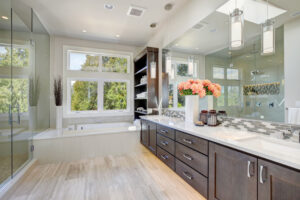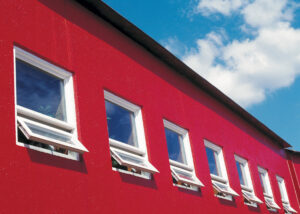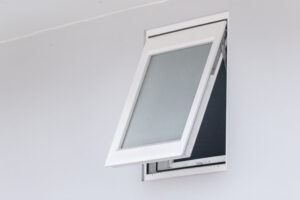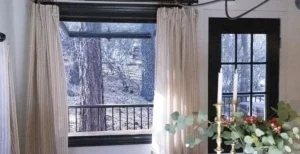A bright and well-ventilated kitchen can lift your mood and make cooking more enjoyable. You want windows that offer style, function, and lasting performance. This guide walks you through the best window for kitchen, exploring design options, materials, and factors that matter most. You will find insights on ventilation, energy efficiency, and everything else that leads to a kitchen you love.
Types of Kitchen Windows
Kitchens come in many shapes, sizes, and styles. Certain window types fit specific layouts better than others. We will dive into each major style—casement, double-hung, bay and bow, sliding, and garden windows. We will also discuss benefits, considerations, and tips for smooth installation and upkeep.
Casement Windows
Casement windows hinge on one side and open outward. They fit kitchens of various layouts and provide strong ventilation control.
Advantages of Casement Windows in Kitchens
Casement windows do not rely on a sliding track. They swing open with the help of a crank or lever, which allows for maximum airflow. If you love fresh breezes while you cook, casement windows make a solid choice. Their design reduces obstructions, and you can capture cool air even with a small opening.
Another advantage: They seal tightly when closed. This can help reduce drafts, which benefits your energy bill and keeps indoor temperatures consistent. A tight seal also dampens outside noise, which is handy if you live near a busy street.
Installation Considerations for Casement Windows
Plan for the extra space needed outside when installing casement windows. Make sure they can swing open fully without hitting shrubs, walls, or outdoor fixtures. Some homeowners mount them higher on the kitchen wall to shield them from busy areas or to accommodate counters and backsplashes.
Professional installation helps confirm a snug, weatherproof fit. If you go the do-it-yourself route, measure carefully for the right width and height. A slight miscalculation can lead to drafts or water leakage.
Double-Hung Windows
Double-hung windows contain two sashes that slide vertically. This classic style works well in many kitchens, especially those with traditional or farmhouse design themes.
Benefits of Double-Hung Windows for Ventilation
Double-hung windows let you open the top sash, the bottom sash, or both. This flexibility allows balanced airflow. Warm air can exit from the top while cooler air enters through the bottom. This is a practical design if you do a lot of cooking. Excess heat, steam, and cooking odors can escape more efficiently.
The sashes also tilt inward, so you can clean them from inside your kitchen. This feature is helpful if your windows are on a second floor.
Design Options for Double-Hung Windows
You will find a range of finishes, grille patterns, and hardware styles to match your kitchen’s overall look. White frames offer a crisp, clean feel, while wood finishes deliver a warm, rustic vibe. Some modern double-hung designs feature built-in blinds or shades between the glass panes, giving you light control without the hassle of dusting.
Bay and Bow Windows
Bay and bow windows project outward from the exterior wall, creating a small nook. They allow more light and can open up visual space in your kitchen.
Enhancing Kitchen Space with Bay Windows
A bay window typically has three panels—one large picture window in the center flanked by two smaller, angled windows on each side. This style can make your kitchen feel bigger by letting in abundant daylight and offering a wide view of your yard or garden.
Bay windows often work well above a kitchen sink or create a cozy reading corner. The ledge they form can double as display space for potted herbs, small planters, or decor.
Creating Breakfast Nooks with Bow Windows
Bow windows usually feature four or more panels arranged in a gentle curve. They look graceful and bring in a panoramic view. When placed in a corner of your kitchen, a bow window can form an inviting breakfast nook. It’s the perfect spot for a small bistro table and chairs.
Bow windows let in lots of natural light, which can help lower the need for artificial lighting during the day. If you have a view of a garden or landscape, bow windows highlight it beautifully.
Sliding Windows
Sliding windows move horizontally along a track. This makes them simple to operate and easy to incorporate into tight spaces.
Space-Saving Features of Sliding Windows
In smaller kitchens where every inch counts, sliding windows shine. They don’t need exterior clearance because the sashes slide within the frame. You can position them above counters, sinks, or areas where a projecting sash might interfere with cabinets or walkways.
Because the sashes slide, you have fewer parts that can fail, which may translate to a longer lifespan with minimal repairs. With good weatherstripping, they also seal out drafts well.
Maintenance Tips for Sliding Windows
Keep the track clean. Debris, dust, or small bits of food can accumulate in the track and hamper smooth operation. Vacuum it regularly, or wipe it with a damp cloth to avoid buildup.
Use a silicone-based lubricant on the track after cleaning. This reduces friction and prevents squeaking. Check for any damaged seals or misalignment in the sashes. Early repairs will lengthen your window’s life and maintain energy efficiency.
Garden Windows
Garden windows protrude outward and feature a glass roof and sides, creating a mini greenhouse effect. They are often placed over the sink, so you can admire greenery while washing dishes.
Incorporating Garden Windows for Indoor Herb Gardens
If you enjoy cooking with fresh herbs, a garden window can serve as your indoor herb station. The design gives plants plenty of light from multiple angles. Basil, rosemary, thyme, and mint thrive in these sunlit alcoves, especially if you water them regularly.
The extra shelf space also supports small potted flowers or decorative items. Make sure you choose plant-friendly glass that filters harmful UV rays if you plan to cultivate herbs year-round.
Lighting Considerations for Garden Windows
Although garden windows let in more sunlight than flat windows, you must still observe the sun’s direction. South- or west-facing windows tend to receive the most intense light, so plan your herb selection accordingly. Some plants, like basil and thyme, do well under strong rays. Others, such as some leafy greens, can scorch easily if the light is too direct.
Consider tinted or low-E (low-emissivity) glass if your kitchen gets harsh afternoon sun. This helps regulate indoor temperatures and protects your herbs and decor from sun damage.
Open Up Windows: A Handy Solution for Modern Kitchens
We believe your kitchen windows should combine flair and function. Our team at Open Up Windows offers an innovative approach that balances indoor comfort with an open-air feel. For a look at our range of pass-through windows and other styles, visit https://openupwindows.com/
Our designs work well for homeowners who enjoy a breezy cooking space but don’t want to sacrifice energy efficiency. We use weather-resistant materials to help you enjoy fresh air without raising power bills. Our pass-through windows are particularly helpful if you like hosting friends on the patio. They let you pass dishes and drinks through a wide opening, which can make kitchen-to-yard entertaining a breeze.
If you want windows that reflect your taste and lifestyle, we can walk you through a variety of colors, materials, and configurations. We aim to make sure our options blend seamlessly into your home’s design. Feel free to browse our website for more details about installation, customization, and maintenance.
Factors to Consider When Choosing Kitchen Windows
Selecting the right kitchen windows goes beyond picking a style. You also want to think about ventilation, natural light, energy efficiency, looks, and maintenance. Let’s break down each factor so you can make a confident choice.
Ventilation Needs
Maximizing Airflow in the Kitchen
Kitchens can heat up fast. Proper airflow clears out steam, smoke, and odors. If you cook often, consider windows with large openings, such as casement or double-hung styles. Bay or bow windows also provide airflow if their side panels open.
Look at your kitchen’s layout too. If the stove is near a corner, a single window might not cut it. You might choose two windows on adjacent walls to create cross-ventilation. Good airflow can improve comfort and reduce moisture buildup that leads to mold or mildew.
Window Styles That Enhance Ventilation
Casement windows excel at pushing air into your home because of their angle when open. Awning windows, a smaller cousin of the casement, pivot from the top and allow airflow even during light rain. Double-hung windows let you adjust the upper or lower sash for more control.
Consider pairing a ceiling exhaust fan with your windows. A balanced strategy offers the best mix of fresh air and odor control.
Natural Light
Optimizing Daylight with Strategic Window Placement
Sunlight can brighten your space and help you reduce artificial lighting. Windows placed near your main cooking areas, dining nook, or sink can fill these spots with natural light. If your kitchen faces north, you might want bigger windows or additional skylights to capture more sunshine.
Placement also matters for controlling glare. If you have direct afternoon sun, position windows so that counters or your cooking range do not receive harsh light. Blinds, shades, or tinted glass can help you manage brightness.
Impact of Window Size on Kitchen Brightness
Large picture windows flood a room with daylight, but they might not always open for ventilation. Smaller windows, on the other hand, can give you flexibility in placement without letting in too much heat.
Bay, bow, or garden windows add depth, letting light enter from various angles. If your kitchen is on the smaller side, extra sunlight can make it feel more spacious and lively.
Energy Efficiency
Selecting Windows with High Energy Ratings
Energy-efficient windows reduce heating and cooling costs. Look for windows with a low U-factor, which indicates better insulation, and a low solar heat gain coefficient (SHGC) to limit heat transfer.
Labels from organizations like ENERGY STAR can guide you toward products that meet certain efficiency benchmarks. Double- or triple-pane windows provide extra layers of insulation. Some come with inert gas fills, like argon or krypton, to slow heat conduction.
Insulation Materials and Their Benefits
Materials, coatings, and seals all affect a window’s insulating power. Vinyl frames contain hollow chambers that trap air, boosting insulation. Wood frames naturally insulate but need occasional upkeep to prevent rot or warping. Composite frames combine materials to offer durability and energy savings.
Low-E (low-emissivity) coatings help reflect heat back to the source. In colder climates, they keep interior warmth from escaping. In hotter climates, they reflect outdoor heat away.
Aesthetic Appeal
Matching Window Styles with Kitchen Design
Your windows should complement your kitchen’s overall vibe. In a modern kitchen, sleek frames and simple lines often look best. A rustic or farmhouse kitchen might call for wood frames or decorative grilles.
Combine style with function. For instance, a minimalist chef’s kitchen might benefit from large picture windows or sliding windows. If you lean toward a cottage vibe, double-hung windows with a classic grille pattern might fit the bill.
Color and Finish Options for Window Frames
Many window manufacturers provide a range of color swatches for frames. You can go classic white, subdued neutrals, or bold hues that match your kitchen cabinets or backsplash. Some frames can be finished to resemble wood grains like oak, cherry, or walnut.
Frame finish can affect maintenance. Painted wood frames require periodic repainting, while vinyl or composite frames often retain color without much upkeep.
Maintenance Requirements
Choosing Low-Maintenance Window Materials
Some materials are easier to clean and maintain than others. Vinyl frames don’t need painting. Aluminum frames resist corrosion, although you might want to check for scratches or dents. Wood frames deliver warmth but need painting or sealing from time to time.
If you prefer minimal fuss, look for windows with tilt-in sashes that let you clean both sides from inside. This feature is common on double-hung and some casement models.
Cleaning Tips for Different Window Types
Remove loose dirt or dust with a soft brush or vacuum attachment. Use a mild window cleaner or water-vinegar solution for the glass. A rubber squeegee can help avoid streaks.
Wipe frames and tracks with a damp cloth. Then dry them thoroughly to prevent moisture buildup. Keep an eye on the seals and weatherstrips. If they show wear, replace them quickly to maintain energy efficiency.
Innovative Kitchen Window Ideas
Sometimes you want more than a standard window. Whether you aim to entertain, enjoy panoramic views, or bring in overhead light, innovative solutions exist to elevate your kitchen design.
Pass-Through Windows
Facilitating Indoor-Outdoor Entertaining with Pass-Throughs
A pass-through window connects your kitchen to an outdoor space. It flips or slides open to create an extended countertop bridging both sides. You can serve food, hand over dishes, or chat with guests on the patio without stepping outside.
This setup can streamline hosting. You don’t have to run back and forth with trays. A quick wipe-down on both sides keeps the surface clean. If you have a bar or island right inside the window, you can create a seamless serving station.
Design Inspirations for Pass-Through Windows
Pick a window style that blends well with your kitchen. Bi-fold pass-through windows stack to one side, while an accordion design folds away neatly. Consider adding stools or high chairs outside for a mini bar vibe.
Choose materials that match your interior and exterior decor. Wood frames can pair well with rustic patios, while aluminum or composite frames suit modern spaces.
Floor-to-Ceiling Windows
Creating a Seamless Connection to the Outdoors
Floor-to-ceiling windows deliver a grand view and flood your kitchen with sunlight. They work best if you have scenic surroundings or a private backyard. These windows can serve as a stunning focal point in open-concept homes.
They also boost the sense of space by drawing the eye outward. You can install them behind a dining area or along a wall adjacent to your kitchen. If you crave an airy cooking environment, this option adds drama and style.
Privacy Solutions for Large Kitchen Windows
Large windows can raise privacy concerns. Frosted or tinted glass can cut visibility from outside. You can also install sheer curtains or motorized shades. Look for materials that resist grease and moisture if the windows are near your cooking area.
In some cases, outdoor landscaping can help. Dense shrubs or a trellis with climbing plants outside your window can create a natural screen without blocking all the light.
Corner Windows
Maximizing Views with Corner Window Installations
Corner windows wrap around two perpendicular walls, giving you a wide-angle view. This design suits kitchens with an L-shaped or U-shaped layout, where countertops meet at a corner.
Corner windows illuminate counter spaces from multiple directions, reducing shadows. If you have an attractive backyard or courtyard, corner windows let you enjoy it from different vantage points while you prep meals.
Structural Considerations for Corner Windows
Corner windows sometimes require additional reinforcement, especially if they replace a load-bearing corner. Consult a structural engineer or experienced contractor for proper support.
You also want to check for water infiltration points. Corner seams must be sealed carefully to avoid leaks. Professional installation is usually recommended here.
Skylights and Roof Windows
Bringing in Overhead Natural Light
Skylights or roof windows let sunlight pour in from above. They are ideal for kitchens with limited wall space or those surrounded by buildings or fences. Skylights also add a sense of openness, drawing the eye upward.
Kitchen islands or breakfast bars often benefit from overhead light. If you have a vaulted ceiling, you can place skylights at angles that capture the best sunlight throughout the day.
Ventilated Skylights for Kitchen Spaces
Some skylights can open to release steam and cooking odors. This can help if your range hood does not fully clear the air. Ventilated skylights use a manual crank or motorized operation. Check for models with rain sensors that close automatically if the weather turns wet.
Materials and Finishes for Kitchen Windows
The frame material and finish can affect durability, energy efficiency, and appearance. We will explore wood, vinyl, aluminum, and composite frames to help you decide.
Wood Frames
Classic Appeal and Insulation Properties
Wood frames bring warmth and timeless beauty. They insulate well, which can help control kitchen temperatures. Many homeowners appreciate the natural grain patterns and the option to paint or stain them any color.
When sealed correctly, wood frames can last for decades. They fit well in traditional or craftsman-style kitchens. They also work in modern homes that use wood accents for contrast.
Maintenance Tips for Wood Window Frames
Moisture and pests pose the biggest threats to wood frames. Check the finish regularly for cracking or peeling paint, which can expose the wood to moisture. Reseal or repaint as needed.
Use a mild soap solution to clean the frame. Avoid harsh chemicals that could strip the finish. Wipe spills promptly, especially near the sink or countertops, to prevent water damage.
Vinyl Frames
Cost-Effective and Low-Maintenance Benefits
Vinyl frames are popular among budget-conscious homeowners. They don’t require painting, resist rot, and clean easily with soap and water. The material also insulates well, helping lower energy costs.
Despite their affordability, quality vinyl frames can last a long time. Some manufacturers add UV-resistant coatings so the color won’t fade in direct sunlight.
Color Options and Durability of Vinyl Windows
Vinyl windows used to come mainly in white, but newer options feature various colors and finishes. The color is often baked into the material, reducing the risk of peeling or chipping.
Durability depends on the frame thickness and construction quality. Look for windows with reinforced corners and multiple hollow chambers. These features enhance strength and insulation.
Aluminum Frames
Sleek Design and Strength Features
Aluminum frames offer a modern look with slim profiles. They are lightweight but strong, which makes them suitable for large window configurations like floor-to-ceiling or corner windows.
Their rigidity also helps maintain shape over time. If you enjoy a minimalist or industrial style, aluminum frames complement that aesthetic. They can pair with large glass panes for expansive views.
Thermal Breaks to Improve Energy Efficiency
Standard aluminum can conduct heat or cold, affecting your kitchen’s comfort levels. Look for aluminum windows with thermal breaks, which are insulative materials placed between the interior and exterior surfaces of the frame. This feature dramatically improves energy efficiency.
Check the window’s overall U-factor to ensure it meets your local energy codes. Adding weatherstripping around the sashes helps reduce drafts.
Composite Frames
Combining Materials for Enhanced Performance
Composite windows blend materials like wood fibers and polymers. They offer the warmth of wood with the low-maintenance benefits of synthetic materials. Some composites also incorporate fiberglass or vinyl for added strength.
This mix makes composite frames resistant to rotting, warping, or fading. They typically provide good insulation and can handle varying climates.
Environmental Benefits of Composite Windows
Many composite frames use recycled or sustainably sourced components. The long lifespan of composite windows reduces the need for frequent replacements, which cuts down on resource use. If you want an eco-friendly option without sacrificing style, composite might be the way to go.
Enhancing Kitchen Windows
Once you settle on a window style and material, you can explore add-ons that boost functionality. Window treatments, decorative glass, and smart tech can all enhance your kitchen’s look and efficiency.
Window Treatments
Selecting Blinds and Shades for Light Control
Blinds and shades help you manage glare and privacy. Aluminum mini-blinds are budget-friendly and easy to clean. Faux-wood blinds give a warmer look. Roll-up shades and Roman shades come in many fabrics, patterns, and colors.
You can also choose moisture-resistant treatments if your windows sit near sinks or food prep areas. Look for materials that won’t warp or trap grease.
Incorporating Curtains and Drapes in Kitchen Design
Curtains add softness and charm. Sheer panels let sunlight filter in while giving some privacy. Heavier drapes can block light and insulate the window area in colder seasons.
Pick fabrics that are machine-washable. Kitchens can be prone to spills and splatters, so easy cleaning is a plus. Short cafe curtains work well for a farmhouse-style kitchen, while floor-length drapes fit a more formal space.
Decorative Glass Options
Frosted and Textured Glass for Privacy
Frosted or etched glass blurs the view while still letting light pass. Textured glass, such as ribbed or hammered styles, adds visual interest. These options suit homes in dense neighborhoods where privacy is a must.
Some homeowners use frosted glass for smaller windows or for the lower half of a double-hung window. This creates privacy while preserving the view from the top.
Stained Glass Accents for Artistic Flair
Stained or leaded glass can bring color and pattern to your kitchen. These windows often become focal points. You can place them in smaller accent windows or as decorative elements in a larger bay window.
Be mindful of how much light the stained glass filters out. If you still need strong natural light, consider partial stained glass panels or sidelights that don’t cover the entire window.
Smart Window Technologies
Automated Blinds and Shades Integration
Motorized blinds or shades let you adjust light levels with a remote or smartphone. You can schedule them to open in the morning for natural light while you brew coffee, then close in the afternoon to keep the kitchen cooler.
Some systems connect to voice assistants. You can raise or lower your shades hands-free, which is handy when you are cooking and your hands are messy.
Smart Glass for Adjustable Transparency
Smart glass can switch from clear to frosted with the flip of a switch. This technology uses electric current to rearrange liquid crystals, changing the glass’s transparency. It is a futuristic way to maintain privacy without blinds or curtains.
Though it costs more than standard glass, smart glass can save space and offer a sleek look. It also blocks ultraviolet rays, protecting countertops and furnishings from fading.
Conclusion and Next Steps
Your kitchen deserves windows that enhance comfort, style, and practicality. Whether you favor the classic charm of double-hung windows or the modern sleekness of floor-to-ceiling glass, focus on balancing airflow, light, and energy savings. Choose frame materials that fit your climate and maintenance preferences. Think about the finer details like window treatments, decorative glass, and smart technology to truly make them your own.
Home improvement decisions can be tough, but it is worth it when you enter a bright kitchen and feel that gentle breeze. Explore different manufacturers, consult professionals if needed, and bring your dream kitchen to life.
Interested in taking your commercial design to the next level? Reach out to experienced window specialists and explore their selection of gas strut models. By choosing the right style and features, you can make a lasting impact and open the doors to new opportunities.
FAQs
What is the best window for kitchen ventilation?
Casement windows excel for ventilation because they open fully and can funnel breezes inside. Double-hung windows also work well by allowing hot air out the top and fresh air in through the bottom.
Are bay or bow windows practical in a small kitchen?
Yes, but measure carefully. Bay or bow windows can add seating or storage in a small kitchen if you plan around the nook space they create.
Which window frames require the least maintenance?
Vinyl and composite frames typically need minimal upkeep. They resist rot, do not need repainting, and clean easily with mild soap and water.
How do I improve privacy with large kitchen windows?
You can add frosted or tinted glass, curtains, blinds, or external landscaping. If you prefer a tech option, consider motorized shades or smart glass.
Should I hire a professional to install my kitchen windows?
Professional installation helps ensure proper fit, sealing, and adherence to local codes. It also usually includes a labor warranty that protects you from potential issues down the line.







